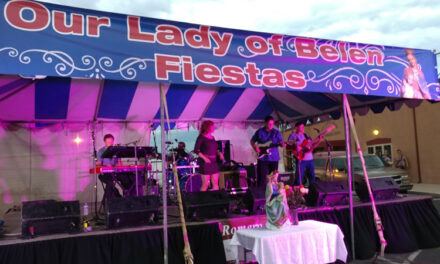Two scientists with the state’s Environment Department say it would be very unusual if any sewage got into a pipe used by residents near the Rio Grande Utility sewer plant in Tomé.
Like all such plants throughout the state, the Tomé plant is permitted and regularly inspected by the State Environment Department staff.
Some Tomé residents reported that sewer water had flooded their community cemetery in July.
Jerald Knutson, a geoscientist with the Environment Department, said he was assigned to oversee the Tomé plant a few months ago, taking over from Fred Kalish, a water research engineering specialist.
“In reviewing the file, I saw there was a public meeting five years ago. Folks at the cemetery had concerns. With their relatives buried there, they are concerned. They are concerned about raw sewage, but it is treated wastewater (coming out of the plant). We have analyzed the water coming out of the plant,” Knutson said.
“If they had the water through the sprinklers, if there was raw sewage, the sprinkler would be stopped up so quickly. I have not seen raw sewage (leaking) in New Mexico before. It would take a catastrophic failure of a treatment plant. I can’t remember when it’s happened. It only could if there’s a blockage or a break of a lift station. You never know, something odd could be happening,” Knutson said. “Regulations allow us to have no adverse impact on ground water.”
Rio Grande Utility has applied for a renewal of its discharge permit, and public hearings will be held in the next few months, Knutson said. Notice will be sent to newspapers announcing the date of the hearings.
Knutson said it is highly unlikely that raw sewage could have flowed onto the cemetery.
“Generally, the most common occurrence of raw sewage is before the treatment, in the collection, where the raw sewage is coming to the plant. If it’s raw sewage (at the cemetery), there would be stuff on the ground. You have to ask, ‘was there toilet paper? Was there floatable stuff, was there fecal material?’
“The situation is, if you make the term raw sewage on the cemetery, you have to ask ‘is there wastewater, treated or untreated, coming off the site onto the cemetery?’ Have they documented it going into the cemetery? It’s not a disclaimer; it will never happen.”
Kalish, who was in charge of overseeing the Tomé plant before Knutson, said, “My understanding is there’s a subset of people who have been concerned and continue to be concerned with the wastewater treatment plant.
“Wastewater enters the plant, is treated and discharged. The plant is operating under a discharge permit issued through the New Mexico Environment Department, Ground Water Quality Bureau. It is inspected on a fairly regular basis. We try to inspect at least every year and a half. I inspected it over the years many times. I am familiar with it.
“Discharge is treated and disinfected. Wastewater is commonly used for irrigation purposes in the state. The New Mexico Environment Department adopted a policy in 1985 to ensure that reused wastewater is adequately treated and disinfected.
“If there were a raw sewage spill, it would be in a collection-line failure to the plant, not from the plant,” Kalish said. “I’ve never seen it in New Mexico. We regularly get calls about unauthorized spills from collection lines. I’ve never seen it at that facility (in Tomé). I don’t want to say the public is right or wrong. I want the public input. It’s hard to imagine how that could happen — raw sewage.”
Kalish said he had understood that “the church had requested effluent (treated water) be used to irrigate the cemetery, and operators left it on. There was a flood over there. In response, the plant has disconnected the line. It would be treated (water).
“The plant is permitted under a discharge permit, and there’s a procedure for reporting unauthorized discharges. The state requires notification. The permit is currently up for renewal. The public will be involved in the process.”
















